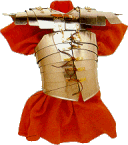 Soldiers Soldiers
Roman helmets were made of
iron; the above is style worn by officers. The crest, not
as a rule so large as the Greek, was, like it, made of metal,
horsehair, or plumes.
Under his armour Roman soldiers wore a rust-red tunica, a
little shorter than that of civilians. Above the neckline of
metal appears, in the representations of soldiers, a roll of
cloth apparently of the same material as the tunica, which
might indeed have been an extra, twisted piece designed to
protect the neck from chafing. 
The lorica or breastplate was of different kinds:
-
Cast metal. The front and back
were hinged and clasped under the arms, and hinged shoulder-pieces clasped onto
the front, as we see on General Antinous Pius
to the right. Only officers wore this style and frequently
not by them, being less comfortable than the other kinds,
all of which employed leather jackets, waist-length, as a
foundation.
-
Overlapping scales
-
Chain (iron links)
-
Plates in sections.
 This is the armor depicted on
the Column of Trajan and is probably the best-known
and most easily reproduced. It may be called "articulated
"and is seen in various styles. The armor to the right has a
widish plate across the chest and one like it in back, and
below these, overlapping, five more horizontal plates. Four
overlapping plates in graduated sizes form the
shoulder-strap.
This is the armor depicted on
the Column of Trajan and is probably the best-known
and most easily reproduced. It may be called "articulated
"and is seen in various styles. The armor to the right has a
widish plate across the chest and one like it in back, and
below these, overlapping, five more horizontal plates. Four
overlapping plates in graduated sizes form the
shoulder-strap.
Any lorica might have, as additional protection,
a short petticoat of leather, metal-tipped tabs, descending
from the bottom of the lorica to hip or mid-thigh, and the same
sort of tabs around the armhole.
Greaves, like those of the Greeks were occasionally, but
not often, included in the armor. Bracchae (bracae)
-- the word is an ancestor of "breeches" -- were adopted by
soldiers for the campaigns in the north, as a concession to
the cold.
They were rather like
modern "shorts," though sometimes narrower and occasionally
longer, always, apparently, long enough to show below the
tunica. Romans scorned them as the garb of barbarians, and
the legionaries removed them before reentering Rome. Nevertheless,
they became more and more popular in the later Empire, and in
the next period were an essential part of all men's
dress.
On their feet soldiers wore caligulae in various
styles, all of open construction and all coming up over the
ankle; they were of brown leather. The officer's
caligulae were more like the calcaeus.
Accessories
 The Roman shield, made of leather stretched on
a metal frame, was oblong, convex, and carried
metal decorations, usually the insignia of a man's legion. The sword
was short and thick, protected by an ornamental scabbard.
Short stocky daggers, worn at the right of the belt, were
often included in a soldier's equipment. A sword-belt, when
worn, was slung diagonally from shoulder to hip. Roman
standards displayed the badges of the companies; the legion
standard was topped by a gilt eagle with spread wings, holding
a thunderbolt in its claws. The Roman shield, made of leather stretched on
a metal frame, was oblong, convex, and carried
metal decorations, usually the insignia of a man's legion. The sword
was short and thick, protected by an ornamental scabbard.
Short stocky daggers, worn at the right of the belt, were
often included in a soldier's equipment. A sword-belt, when
worn, was slung diagonally from shoulder to hip. Roman
standards displayed the badges of the companies; the legion
standard was topped by a gilt eagle with spread wings, holding
a thunderbolt in its claws.
Sources: History of Costume,
Historic Costume for the Stage by Lucy Barton
Updated
|
